Table of Contents
ToggleIntroduction
Do you require a strong tugboat rope? Safe towing is critical for all maritime operations. Our guide assists you in making an informed decision by investigating rope materials. We emphasize the critical need for strength and ensure safety is a primary concern. Let’s help you find the right tugboat rope for your vessel.
Why Is Selecting The Right Tugboat Rope Crucial?

The tugboat is a powerful vessel in the maritime industry. Each tugboat has a line, which is one of the most important parts of the vessel. This line helps a larger, slower vessel move safely through difficult passages. It is also used for towing a barge through a narrow channel. Therefore, in this scenario, it is very important to choose the correct rope. For example, a high-performance synthetic tugboat rope adds safety by minimizing snap-back risks.
Have you ever witnessed a snap-back event? The recoil reduction is often up to 80%. This leads to a drastic decrease in hand injuries and improves crew safety, which is the ultimate goal. I’ll never forget the sound of a line snapping on my first vessel; it’s why I’m passionate about this topic.
A rope with 95% strength retention offers reliable performance. It also prevents accidents like groundings, even if it’s a used tugboat rope in good condition. A fatal tugboat snapback rope accident can be prevented with the right line.
Materials Used in Tugboat Ropes!
In this section, we will focus on high-performance synthetic fibers. We will also discuss what materials make up ropes and their properties.
A. High-Performance Synthetics
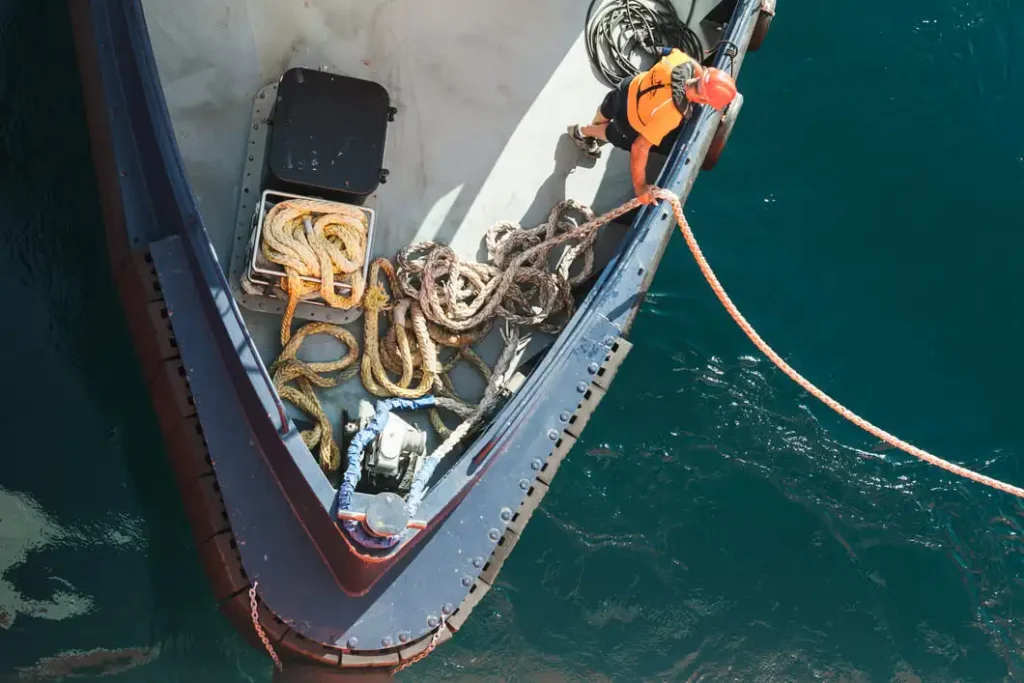
Synthetic fibers have truly changed the industry. They offer high strength and great durability compared to older options. As Samson Rope, a leading manufacturer, states, “High-performance synthetic ropes… offer significant improvements in safety and handling over steel wire.”
1. Polyolefins
Polyolefins are a specific type of synthetic rope. We will focus on UHMWPE, Dyneema, and Polypropylene.
UHMWPE
UHMWPE is an ultra-high strength synthetic material. This tugboat UHMWPE rope is extremely lightweight. It is perfect for demanding pulls and often replaces steel cables.
Dyneema
Dyneema is a high-performance synthetic. This line is often called the world’s strongest rope. DSM, the makers of Dyneema, claim it is “15 times stronger than steel on a weight-for-weight basis,” revolutionizing high-load applications. These tugboat ropes have a higher strength-to-weight ratio than steel.
Polypropylene
Polypropylene ropes are lightweight and can float on the surface of water. These ropes, however, do deteriorate from UV rays. They are best used as floating mooring rope.
Spectra
Spectra is another brand of HMPE fiber. This strong rope is lightweight for towing. It has high abrasion resistance and offers great strength.
2. Polyamides (PA)
Polyamides offer varying traits. This group mainly consists of Nylon, which has very high elasticity.
Nylon
Nylon has great strength and stretch, which makes it stand out. It is often considered for a tugboat rope replacement. It is also great for mooring and anchoring lines.
Shock Absorption
Nylon’s elasticity is crucial for shock absorption. This trait, similar to tugboat rope, takes loads from waves to protect the cleats. Have you ever felt the jarring motion when a line doesn’t stretch?
High Stretch
A nylon mooring line is very easy to stretch. A tug boat rope in this category can stretch up to 10 to 20 percent, which is a good range.
Reduced Strength (Wet)
The most important downside is that Nylon’s strength is reduced when wet. According to BoatUS, “Nylon’s shock absorption is a plus, but its 10-15% strength loss when wet is a critical trade-off every boater must manage.” This is a significant drawback. This tugboat rope might need to be replaced first because of this weakness, along with UV light damage.
3. Polyesters (PET)
Polyester is one of the most common materials used. It has a good balance of strength and low stretch, along with being durable.
Polyester
Polyester is very common and is great for mooring purposes. Used tugboat rope for sale made from polyester still retains good strength.
Low-Stretch
Offering low-stretch capability is advantageous. This allows it to be used in running rigging, halyards, and control lines.
UV Resistant
This is a very impressive material with superior UV resistant traits. A line can be left in the sun for over 300 hours and will still maintain its strength.
Recycled rPET
This is the only option that contains some sustainability. This new tugboat rope repurposes materials that are rPET (recycled). These come from the collection of used PET packaging.
4. Aramids
Aramids are known for strength and heat stability. Some fibers in this group include the popular Kevlar and Technora.
Kevlar
Kevlar is over five times stronger than steel. This material is recognized for its immense strength. It is often sold for use in tugboat rescue attempts as an emergency boat tow rope.
Technora
Another aramid fiber is Technora. It is a fiber that has a very high-strength core and great heat stability.
800°F+ (Extreme Heat)
The melting point of aramids is exceptionally high. DuPont, the creators of Kevlar, confirm that it “maintains its strength and resilience at temperatures up to 800°F (427°C).” This is important in tugboat operations and in rough towing conditions.
LCP (Vectran)
LCP (Vectran), in particular, is five times stronger than steel. It is also known for reduced elasticity when compared to HMPE. This is a static blue synthetic tugboat towing rope that is used as halyards or a tugboat towing rope.
B. Fiber Grades & Properties

Not all fibers are the same. Knowing the grades, buoyancy, and construction of the rope is important for selection.
1. HMPE Grades
HMPE fibers are broken down into various grades. Each grade has differing strength and creep performance.
SK38
SK38 is a standard HMPE grade. It is a very strong fiber, yet more basic in structure. This serves as a good starting point in synthetic marine tow rope operations.
SK78
SK78 is a renowned, high-grade type. It is significantly stronger and has a lower creep than SK38. This makes for a well-performing tugboat tow line.
SK99
SK99 is the current most advanced grade. It has the utmost strength. These specialized tugboat ropes are used for high-demand and high-load racing.
Higher SK (Stronger)
The rule is simple: the higher the SK number, the stronger the fiber. Higher grades also mean lower creep. Thus, the rope is more stable and stronger.
2. Buoyancy Properties
Buoyancy is an essential feature for mooring lines. It is the quality that allows a rope to float or sink. This floating or sinking quality can affect the ease of handling. Have you ever had to fish a heavy, waterlogged line from the harbor?
Polypropylene (Floats)
Why do certain tug ropes float? They are made with Polypropylene, which floats. This allows the lines to be easily retrieved. It also provides ease and efficiency for rescue purposes.
HMPE (Floats)
Dyneema and other high-end HMPE fibers are both strong and incredibly light. This makes them ideal for a boat recovery rope as they do not sink. This, in turn, prevents entanglement with propellers.
Nylon (Sinks)
Nylon ropes fail to float. This means they can be used as anchor lines. Sinking mooring ropes for ships also avoids propeller entanglement from passing vessels.
Polyester (Sinks)
Polyester also sinks in water. This popular material is used for anchor rodes. You can often find used tugboat rope for sale made from polyester.
3. Rope Core
The rope core is its heart. It consists of fibers that determine the rope’s main characteristics.
Parallel Fibers
The core often consists of parallel fibers. This unidirectional construction provides low stretch and high strength. It also impacts the final tugboat rope sizes.
Unidirectional Core
A unidirectional core fiber is common in high-performance lines. This design is very strong. It creates a low-stretch rope for a tugboat used for halyards or sheets.
Determines Strength
The core determines the strength of the rope. It may be surrounded by a second core for added rigidity. This heart defines the breaking load for the tugboat line.
Determines Elasticity
Elasticity is also determined by the core. For example, a nylon core provides high stretch. A polyester core, in contrast, offers low stretch of 5-7% for sheets.
4. Rope Jacket
The rope jacket is the rope’s protective outer layer. These braids are braided around the core of the rope.
Protects Core
The jacket’s main job is to protect its core. In a double-braid rope, a braided core is surrounded by a braided cover. You can find this durable rope from tugboat rope suppliers or checking for tugboat rope near me.
Braided Cover
A braided cover is smooth and easy to handle. This outer layer is what comes into contact with the winches. It is what makes the line flexible.
Abrasion Resistance
The jacket is useful for providing friction and abrasion resistance. A line with a cover is abrasion resistant. This cover is often made of polyester fibers.
Hand Contact
This is the cover that the operator grips. A double-braid construction is much easier to handle. Tugboat rope suppliers advocate it because it has smooth surfaces.
C. Rope Construction Types
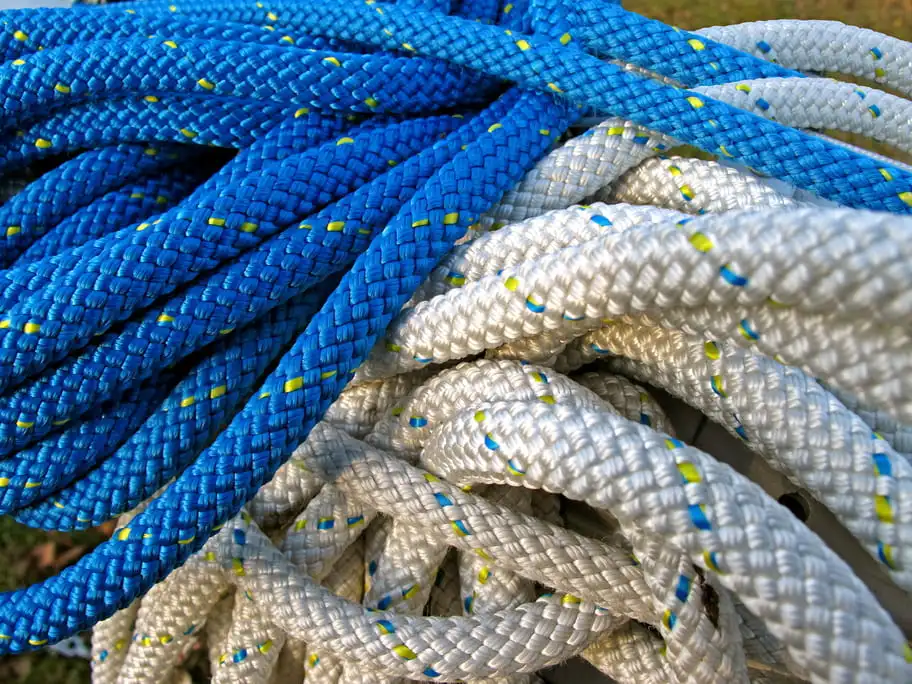
There is more than one way of making ropes. These include braided and plaited, with each having its individual characteristics.
1. Braided Ropes
These types of tugboat rope are unique because they have a core and a cover. This construction gives the rope an excellent balance of strength and flexibility.
Double-Braid
A double-braid rope has a braided core surrounded by a braided cover. This construction is very supple and strong. It also helps to prevent a tugboat rope accident.
Single Braid
Single braid ropes have no breaks in them, making them one single piece. This design is lightweight and easy to carry. Also, single braid ropes offer a decent balance for this kind of line.
Braided Core
Every double-braid line has a braided core, which serves as the rope’s strength. This core is then protected by a braided cover.
Braided Cover
The braided cover makes the rope easy to handle. It is also smooth on the hardware, which reduces friction.
2. Twisted Ropes
Twisted, or 3-strand, rope is one of the oldest types of rope. Its constituent strands are twisted around one another.
3-Strand
3-strand twisted cordage is a design that has stood the test of time. It remains tough and elastic. It is still a common choice for dock lines and the rope fender tugboat bumpers on a traditional vessel.
Twisted Strands
This type of line is very stretchable. It can be sold for a low price due to the 3 twisted strands used in this construction.
Easy Splicing
This is a great advantage. What an operator can do with this rope is customize it to a certain size and strength that is needed.
Kink Formation
A disadvantage is that kinks can form on the tugboat tow rope over time. This construction is also less lean than a braided rope.
3. Plaited Ropes
Plaited ropes are also known as square braids. Generally, this large tugboat line rope is used for mooring and anchor lines.
Squareplait
Squareplait ropes are plaited 8-strand or 12-strand lines. In commercial shipping, they are used for spring and tugboat tow ropes.
8-Strand
8-strand plaited rope is a common multiplait construction. This rope for a tugboat is usually for anchor ropes and fender lines on large vessels.
12-Strand (PR-12)
12-strand (PR-12) ropes are also used. This is available in diameters from 16mm for industrial mooring.
Multiplait
Multiplait is the common term for 8-strand or 12-strand square braids. This type of line is more supple and manageable.
Analyzing The Strength of Tugboat Ropes!
Strength is very important in safe operations. This includes measurements such as bollard pull and breaking load. The Maritime Executive highlighted a report where “mooring operations remain a high-risk activity, with rope failures being a primary cause of incidents.”
A. Key Strength Metrics
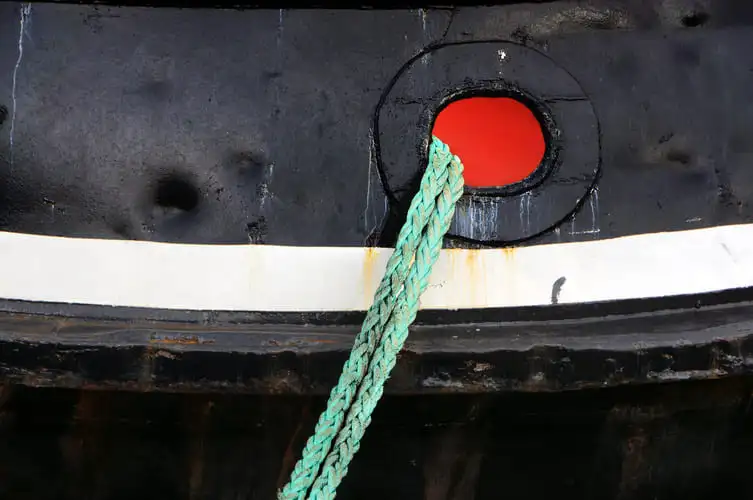
We will discuss and define breaking load, strength testing, and bollard pull. Their significance helps us understand a rope’s capability.
1. Bollard Pull (Tug)
Tugboats operate with a certain amount of power known as bollard pull. This is the thrust produced while stationary.
Pulling Power
This metric helps to understand the sustained load the tugboat can hold. It is a critical measure of the tug’s power.
Zero Speed
In this case, we discuss the scenario of a tugboat at maximum thrust and anchored to a pier. It is safe to state that the tugboat’s thrust is measured at zero ahead speed.
500-600 kN
On average, a midsized tugboat can exert 500 to 600 kN of bollard pull. This force requires a heavy-capacity rope.
(TF) Tonnes-Force
Bollard pull is computed in kilonewtons (kN). Sometimes, it is derived in tonnes-force (tf) for the certification of every tugboat.
2. Bollard Pull Types
There are two types of bollard pull. These are Static Bollard Pull and Continuous Bollard Pull.
Static Pull
Static Pull is measured a few seconds after the test commences. This is when the vessel can exert maximum thrust in still water.
Continuous Pull
Continuous pull is the type of pull where the measurement is taken for 10 minutes. This is often a lower, yet more realistic, scale. It tests the true endurance of the entire line system.
10 Minutes
This 10-minute span is sufficient to ascertain if sufficient power is delivered to the engines. This ensures the propulsion system can support the entire load. These figures are referred to as continuous bollard pull.
3. Rope Breaking Load
The rope must have a high breaking load. This is to withstand huge pressures and extreme weather.
High Breaking
A rope for a tugboat requires a high breaking load to keep the vessel well fastened. This ensures the boat is secured in extreme conditions.
Tensile Strength
Tensile strength pertains to the maximum load a line can bear. An example is Kevlar, which boasts a tensile strength over five times that of steel.
95% Retained
Premium quality types of tugboat rope can retain 95% of their strength. They resist elongation or breakage, which guarantees dependable performance under massive loads.
Global Standards
A tug’s line must comply with global standards. These standards are certified by classification societies like the American Bureau of Shipping (ABS).
4. Strength Testing
It is mandatory to perform extensive strength testing on the ropes. This testing ensures the ropes are strong, durable, and compliant with necessary standards.
Comprehensive Tests
OEM ropes are subjected to intensive testing. This results in reliable toughness and ensures the line is both strong and durable. Our rigorous processes at Duracordix guarantee this quality.
99% Success
Unrivaled consistency is a promise held by tier-one ropes. They can guarantee reliability with a 99% success rate. This is evident in the reviews tugboat rope gets from professional crews.
Durability (Tested)
Durability (Tested) is a pivotal measure. A line must be tested and last 30% longer than the average. Beyond this, the rope ought to last 40% longer in extreme weather.
IRS / ABS
Bollard pull certificates are mandatory. These are granted by classification societies, which include the Indian Register of Shipping (IRS) or American Bureau of Shipping (ABS).
B. Material Strength Comparisons
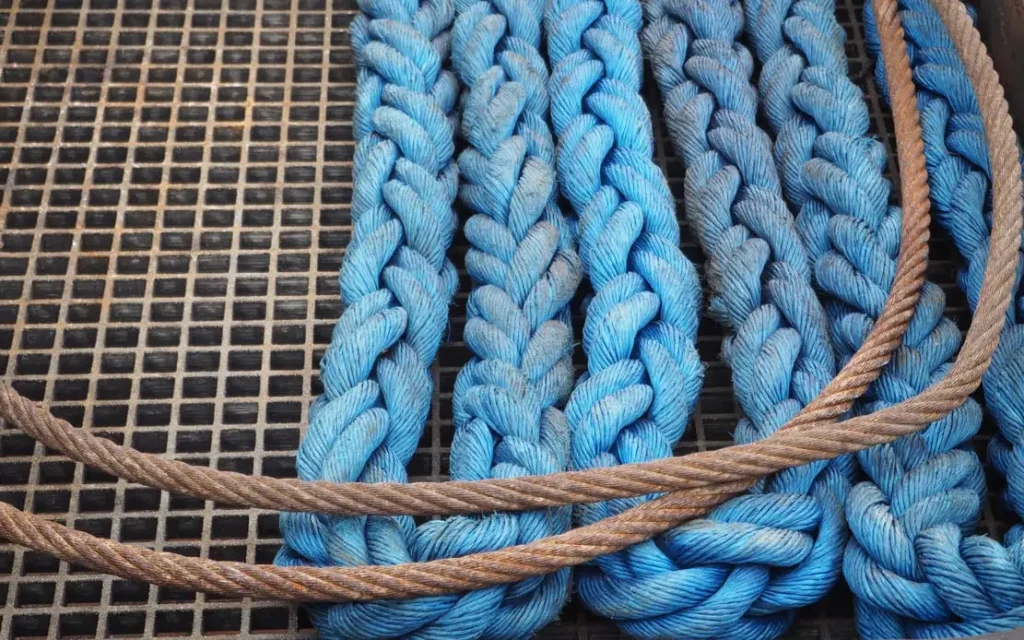
Strength varies from one material to another. For example, modern synthetics easily outperform traditional steel.
1. Synthetic vs. Steel
Steel rope has a strong, durable substitute. Synthetics are more secure, lighter, and generally stronger. I’ve personally handled both, and the ease of synthetics is a game-changer for any crew.
5x Steel (Kevlar)
A Kevlar (aramid) tow rope is five times stronger than steel. This extra strength is useful for the rescue of tugboat rope lines.
5x Steel (Vectran)
LCP (Vectran) is also five times stronger than steel. This strong rope can hold static loads, such as halyards, due to its very low elasticity.
700% Lighter
Synthetic ropes have the impressive feature of being 700% lighter at equal strength. This lighter weight increases the rope’s usability, regardless of the size tugboat rope you need.
Surpassing Steel
The strength-to-weight ratio of HMPE fibers is amazing and far exceeds steel. This means a synthetic HMPE line can replace steel cables in high-load applications.
2. Aramid Strength
Aramid Strength holds an unmatched position in certain areas. These areas include off-roading and rescue operations.
Immense Strength
Heavy loads can be supported by a tugboat rope due to Kevlar and its strength. This offers performance because it is known for its immense strength.
Heavy Loads
Aramid is essential for lifting and hauling heavy loads. A tug boat rope made from Kevlar is durable enough for military and mining use.
High Modulus
Aramid (Technora) has a high modulus (rigid) property. This makes the rope stable but may not dampen vibrations well.
High Tensile
This black tugboat rope highlights that Kevlar has high tensile strength. It is able to endure harsh conditions.
3. HMPE Strength (Dyneema)
Dyneema (HMPE) Strength ropes are extremely light and durable. This makes them ideal for high-load and demanding pulls.
Ultra-Strong
This tugboat rope has ultra-strong Dyneema. It is a synthetic material that has greatly impacted the marine field with its strength.
World’s Strongest
This rope for a tugboat, considered the world’s strongest, is perfect for heavy-load work like rigging and lifelines.
High-Load
These fibers are perfect for high-load situations. The line can pull heavy loads without elongation or breakage.
SK99 (Strongest)
SK99 (Strongest) is the highest level of HMPE grade. You may find this on ebay tugboat rope listings for the lowest creep rate.
4. Conventional Synthetics
Nylon and Polyester are still the standard in the market. They give a good balance of strength, cost, and durability.
Nylon (Strong)
Known for its remarkable strength, nylon rope is reliable and has remarkable endurance. It makes a strong man tugboat rope for anchoring.
Polyester (Strong)
Polyester is also very strong and offers excellent UV resistance. It is a fantastic all-around choice for many marine applications.
Polypropylene (Lower)
Polypropylene (Lower) ropes are strong, but less so than Nylon. This line has low friction resistance. It is not ideal for high-load tasks.
C. Strength & Performance Dynamics

What are strength and performance dynamics? They include breaking load, stretch, shock absorption, and weight. These are critical performance dynamics.
1. Stretch & Elongation
Stretch & Elongation is key to absorbing forces. Different materials have high and low stretch capabilities.
Low Stretch Kevlar
Kevlar tow rope has a low stretch quality. This type of line is very rigid. So, it can be used for static loads where high precision is required.
Low Stretch Polyester
Polyester also has low stretch properties. This makes it a reliable choice for lines that need to stay taut, such as halyards.
High Stretch Nylon
Nylon has an edge due to its high stretchable nature. This line is more elastic than polyester. It is ideal where high stretchability is required.
2. Shock Absorption
Shock Absorption is essential for dynamic loads. It absorbs oscillations from waves and wind.
Nylon
Nylon is vital for anchoring, where shock absorption is critical. This tow line for boat use absorbs the load on cleats and protects the hardware.
High Elasticity
Moored tugboats require ropes that can stretch 10% to 20%. This allows for lateral swinging and proves how crucial high elasticity is.
Compensates Waves
This stretch compensates for wave motion. It protects the deck cleats from jarring forces. This means the boat moves more smoothly.
Absorbs Gusts
Sheets on a sailboat have 5-7% elasticity. This means the ropes have stretch covers perfect for absorbing gusts and wind shifts when sailing.
3. Weight-to-Strength
The weight-to-strength ratio is a major factor. Modern synthetic materials easily overcome the heavy weight of steel cables.
700% Lighter
Synthetic rope is 700% lighter than steel of the same strength. This weight difference proves both safety and ease for handling the tugboat rope on deck.
Lightweight (Dyneema)
HMPE fibers are commonly known for their lightweight properties. This means there’s a line that floats. This both decreases weight and increases performance.
4. Strength Durability
Strength durability protects the rope. Ropes are tested to withstand the most extreme conditions.
30% Longer Lifespan
Durable ropes have lifespans 30% longer than the average rope. This really cuts costs. Look for tugboat rope suppliers for this rope.
40% Longer Weather
All-weather champions last 40% longer than normal in extreme conditions. This line guarantees durability in rough marine conditions.
Resists Breakage
A strong line supports heavy loads while maintaining its strength. This means the rope does not elongate or break during operations.
95% Retained
Quality synthetics lose only 5% of their strength. This performance guarantees the rope won’t fail under load. This justifies the price tugboat rope commands.
Safety Considerations Of Tugboat Ropes!
The priority in towing is safety. Synthetic ropes are the safest option compared to steel wire.
A. Enhanced Operator Safety

Synthetics increase operator safety significantly. They are designed to lessen recoil and hand injuries.
1. Reduced Recoil
Steel wire has the deadly risk of snap-back. Ropes are designed to lessen the risk of dangerous lash-back.
80% Lower Recoil
Synthetic rope lowers recoil by an astonishing 80%. This greatly reduces the possibility of a fatal tugboat snapback rope accident compared to lines made of steel wire.
Lower Kinking
The low kinking of synthetic materials, combined with reduced recoil, greatly reduces the risk of injuries. This increases the safety of the line.
Minimized Lash-back
Kevlar, unlike steel cables, lessens lash-back. This is important in the event the line breaks. This increases the safety of all crew members on deck.
Safer (Steel)
When compared to steel wire rope, a line made from synthetic materials is considerably safer. The 80% reduced recoil and reduced kinking help improve safety.
2. Injury Reduction
The construction of synthetic ropes directly contributes to injury reduction. This is through lighter weights and smoother surfaces.
60% Reduced (Hand)
The smooth surface can result in a 60% reduction in hand injuries. Steel cables, by contrast, can snap dangerously. This rope made for tugboats is safer.
99.9% Incident-Free
The best options for tugboat ropes come with a 99.9% incident-free rate. This protects all users. They can safely and confidently know the rope is reliable.
Smooth Texture
A smooth texture greatly enhances safety. There are reports of a 60% reduction in hand injuries for this design. It makes handling the line a lot safer.
3. Handling Safety
Rope weight is a critical factor in handling safety. Lighter ropes are easier to handle and much safer to deal with.
Easier Handling
This line lessens the physical effort exerted by the crew. The 700% weight reduction guarantees minimal effort is needed.
Safer Transport
Transporting a line becomes safer when the rope is lighter. This improves efficiency and lowers the potential injury risk from moving the rope.
Safer Storage
It is easy to properly store lightweight ropes for safety. Coiling this lightweight tug boat rope makes it neat, tangle-free, and safe.
4. Firefighting (SOLAS)
As per the SOLAS directive, tugboats need to be ready for firefighting. This includes ropes that can endure extreme temperatures.
SOLAS (Mandated)
Each line and vessel must operate according to SOLAS (mandated) rules. This means all support tugs are permitted to carry out firefighting activities.
All Tugs
All support tugs are fitted to perform basic firefighting. However, there are also specialized firefighting tugboat vessels designed for rapid response.
800°F+ Kevlar
Kevlar line is designed to withstand heat over 800°F (427°C). This is critical during high-friction operations or firefighting.
High Heat Resistance
The ideal line for high heat resistance is made from aramid fibers like Kevlar. This makes the line ideal for an emergency boat tow rope.
B. Environmental Durability (Safety)
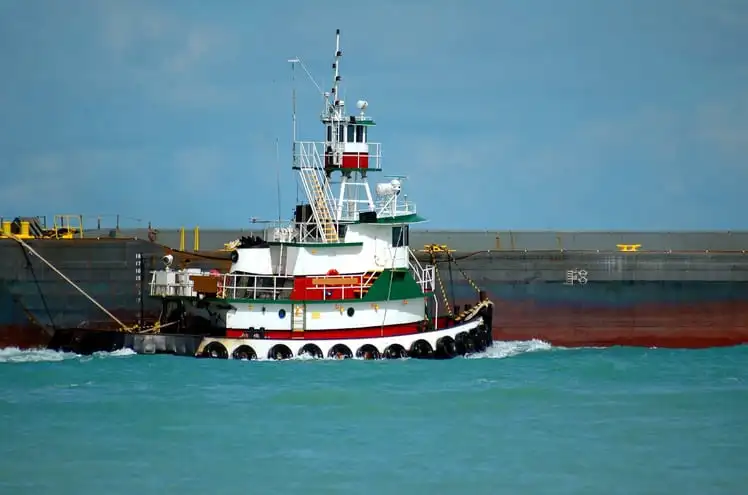
Environmental durability (safety) is a core concern. Ropes need to withstand abrasion, UV light, and chemicals.
1. Abrasion Resistance
All mooring ropes must withstand high levels of abrasion. Therefore, good abrasion resistance is very critical for a long life.
High Abrasion
A line requires high abrasion resistance. It protects the line from sharp edges on concrete or rusty rings at the mooring point.
Kevlar Resistant
Kevlar is a tested and abrasion-resistant line. This is an alternative to steel wire, enduring high abrasion and heavy loads.
High Dyneema
Dyneema (high) is protected from abrasions. This type of Dyneema line is meant for use in applications with extreme workloads.
Good Polyester
Good abrasion resistance is one of the characteristics of polyester fibers. This form of polyester rope is perfect for securely fastening a boat.
2. UV Resistance
Good defense against UV rays is necessary. Sunlight, which can last for 300 hours per month, is a menace to synthetic materials.
UV
UV (essential) resistance in a line is a must. Ropes must be kept away from direct sunlight to minimize exposure and damage.
Polyester
Polyester (resistant) line boasts impressive UV resistance. This rope loses very little strength even after long periods under sunlight.
300 Hours
Certain months have up to 300 hours of sunshine. This clearly indicates that for any line left on deck, UV resistance is strongly needed.
Polypropylene Degrades
Polypropylene (degrades) is one of the materials that degrades the fastest under UV light. This line will likely be replaced more frequently.
3. Chemical Resistance
Ropes must possess resistance to withstand contact with seawater. This attribute prevents ropes from being damaged and eroded in the marine environment.
Polyester
Professional boaters appreciate the polyester (resistant) line. It has high resistance to damaging chemicals.
Nylon
This type of nylon line (resistant) is also resistant to abrasion and chafe. It has high resistance to damaging chemicals.
HMPE
This type of HMPE line (resistant) is not deteriorated by seawater, oil, or chemicals. It is resistant to corrosion.
Seawater
Seawater (resist) corrosion leaves behind salt crystals. It is important for a line to resist this. HMPE fibers withstand corrosion from seawater.
4. Water Resistance
A rope’s water resistance is vital. Some fibers lose strength when submerged, while others exhibit hydrophobic behavior.
Retains Strength
Polyester is a common choice for lines. It is one of the few synthetic options that retains its strength when submerged.
Reduces Strength
The nylon line will lose strength when wet, which is a severe disadvantage. This is why polyester is frequently the go-to replacement.
Hydrophobic
A water-resistant line is hydrophobic. This is one of the top considerations for any marine rope.
Resists Moisture
Natural fibers shrink when they contact moisture. Synthetic fibers like polyester are far more reliable as they do not absorb water.
C. Key Rope Safety Risks
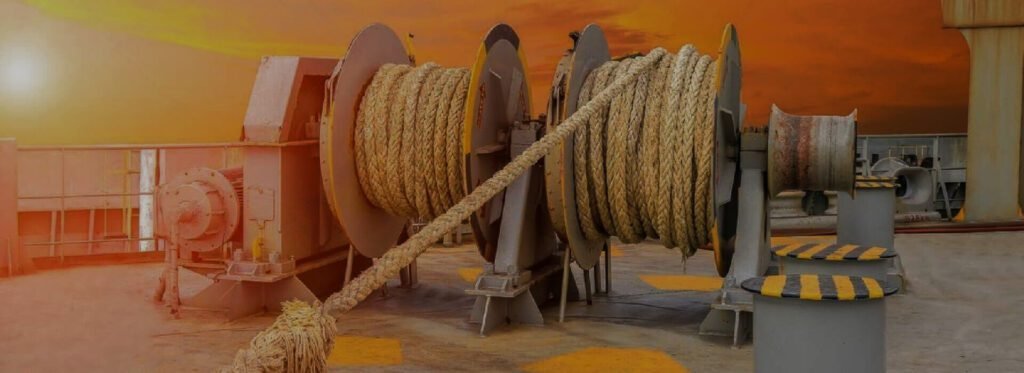
Several key rope safety risks are common. Examples include undersizing, mooring point hazards, and abrasion.
1. Sizing & Condition
Correct sizing and condition are critical for safety. No compromises can be made on the rope’s diameter and breaking load.
Undersized
Mooring ropes that are undersized (insecure) are far too weak. If the rope is too thin, it will fail.
Oversized
An oversized (no stretch) line will not stretch enough. This lack of stretch can transfer jarring shocks directly to the vessel’s hardware.
No Compromises
You really can’t make any compromises. The line’s diameter and breaking load must not be compromised.
Replace If Damaged
If a line is damaged, it must be replaced. If the rope cannot firmly steady the boat, it is mandatory that the rope be changed.
2. Mooring Point Hazards
Mooring Point Hazards are risks hidden at fastening points. They can be sharp edges, concrete burrs, or rusty metal.
Sharp Edges
Lines suffer damage from abrasion when they contact sharp edges on concrete. Ropes with high abrasion resistance, like polyester, are needed.
Rugged Wood
Mooring points with rugged wood expose the rope to chafe. Lines wear from these rough edges, which weakens the rope.
Protective Cover
Adding a spliced-in protective cover helps increase abrasion resistance. This simple addition prolongs the life of a line.
3. Capsizing / Girting
Capsizing or girting is a major risk. This risk level changes with the tugboat’s configuration.
Conventional Risk
Risky conventional tugboats are more likely to capsize. This makes them the most dangerous type of tugboat for this specific risk.
ASD (Aft Risk)
ASD tugs are also susceptible to capsizing. The risk is greatest when using the aft towing position.
Tractor Less
Tractor tugs are far less susceptible to capsizing. They are safer choices in confined waters due to their simpler handling.
Release Hook
A release hook is one step that can be taken to address this issue. This is a critical piece of equipment on conventional tugs to avert girting.
4. Physical Damage
Wear and tear from normal operations can be controlled. However, physical damage, abrasion, and hardening still need to be managed.
3-Strand Kinking
Kinking in 3-strand cordage can lead to “kink formation” and a tugboat rope breaking. Braided ropes are more kink-resistant.
Age Hardening
Lines made with 3-strands generally do not harden with age. Other ropes, however, may become hard and brittle from exposure to salt and dirt.
Brittle Areas
Do you feel hard, brittle areas on your line? Running the rope slowly through your hand will help you feel them.
Chafe Abrasion
Chafe on a tugboat is a common occurrence. Ropes that rub against a sharp edge will have their fibers severed over time. Chafe and wear should be examined at least once a year.
How Do You Select The Right Tugboat Rope?

Choosing the perfect rope can be difficult. You have to think about the construction and materials, as well as the application.
Vessel Bollard Pull
You need to be aware of the vessel bollard pull. This metric, which ranges from 500 to 600 kN, indicates the pulling strength. The rope’s MBL should always be significantly higher than the bollard pull.
Tug Type
The type of tug (ASD, Tractor) is important. Tractor tugs are more versatile, while ASD tugs have complex controls and risk capsizing when aft-towing.
Operating Area
Take into consideration the operating area (Harbor, Offshore). A Harbor Tug works with pinpoint accuracy in confined spaces. Offshore operations require endurance for towing over long distances on open water.
Towing Method
The towing method (Direct, Indirect) also comes into play. Direct towing is when a vessel is towed at a slow pace. Indirect towing allows for greater rotational movement of the vessel.
Safety Factor
Safety is a major component that should not be compromised. A common misconception is that rope does not offer a safety factor (5:1). This industry rule must not be neglected.
MBL
The rope must have a high MBL (Breaking Load). The fundamental rule is that it must withstand heavy loads during extreme weather. Small ropes are not able to secure the target.
Environmental
Flexibility to handle crosswinds and waves is very important. This allows for greater maneuverability. Elastic ropes also offer comfort to those on the vessel.
| Material | MBL vs. Bollard Pull (Factor) | Elasticity (Wave/Shock) | Primary Use (Harbor/Offshore) | Weight (Density) | Recoil Risk (Safety) |
| HMPE | >5:1 (High MBL) | Very Low (<2%) | Harbor (ASD/Tractor), Offshore | Very Light (Floats) | Very Low |
| Aramid | >5:1 (V. High MBL) | Low (~2-4%) | Harbor (High Temp) | Light (Sinks) | Low |
| Polyester | >5:1 (Good MBL) | Medium (~10-15%) | Harbor, Offshore (Towing) | Medium (Sinks) | Medium |
| Nylon | >5:1 (Good MBL) | High (~15-25%) | Offshore (Shock load) | Medium (Sinks) | Medium-High |
| Steel Wire | >5:1 (High MB) | Very Low (<1%) | Offshore (Direct Tow) | Very Heavy (Sinks) | Extremely High |
Tugboat Rope Technical Comparison!
How to Match Rope to Tugboat Operations?
Harbor Tugs
The precise capabilities of the Harbor Tug are most important. They carry the most work in busy ports. Ropes of low-to-no stretch are essential for them. They work best with polyester ropes or double-braid lines for docking in tight areas. At the same time, installing LED loading dock lights enhances visibility, ensuring your safety and efficiency during operations in low-light or nighttime conditions.
Ocean Towage
Ocean Towage tugs carry out exceptionally long-distance tows. These vessels require durable tugs. When dealing with open water, nylon or high-strength synthetics are better.
Anchor Handling
Anchor Handling (AHTS) tugs are considered quite powerful. These vessels deploy and retrieve heavy anchors. For this task, super-strong and abrasion-resistant HMPE Dyneema or SK99 ropes are a requirement.
Salvage
Marine Salvage (SAR) tugs are used to recover ships that have run aground. These vessels require rope of high tenacity with minimum elongation. The best rope to use in this scenario is Kevlar.
Ice Breaking
Ice breaking tugs use unique hulls and special ropes to clear paths of ice. Most of the time, these vessels use synthetic composite ropes. These ropes must withstand high shock and extreme cold.
River Towing
River tugs often tow barges. Most of these vessels require 8-plait ropes. These ropes must be durable, abrasion-resistant, and easy to carry. A long tugboat rope is common here.
Firefighting
All tugs must follow Firefighting (SOLAS) regulations. This includes having ropes that do not melt at high temperatures. Kevlar is best for this, as it has a melting point over 800°F.
Synthetic Vs. Steel Wire Tugboat Rope!
The choice between synthetic and steel is clear. High-performance synthetic rope is the better choice. It offers greater benefits in safety, application, and handling.
Weight
Synthetic line is 700 percent lighter than steel wire of the same strength. It is lightweight and easier for the crew to handle.
Handling
Easy handling, transporting, and storage come from lightweight features. Installation is a walk in the park because Kevlar ropes are 80% lighter than steel cables.
Recoil
An 80% reduction is noted in recoil and kinking with synthetics. Snap-back accidents, a great danger with steel wire, are now an issue of the past.
Strength
The strength of steel is matched and even surpassed by synthetics. Kevlar is five times stronger than steel. HMPE (Dyneema) also surpasses steel’s strength-to-weight ratio.
Maintenance
Steel wire needs heavy maintenance and lubrication. This is in direct contrast with synthetics, which only need to be rinsed with fresh water to get rid of salt.
Corrosion
HMPE fibers do not corrode from seawater, oil, or chemicals. This is unlike steel wire, which rusts and degrades in a marine environment.
Lifespan
A quality synthetic rope has an average lifespan 30% longer than most ropes. It also lasts 40% longer in extreme weather, saving on replacement costs.
Future Trends in Smart Tugboat Rope Technology!
The industry is always changing. Besides automation and smart integration, line technology still focuses on custom, stronger fibers.
OEM Customization
Specific solutions are obtained through OEM Customization. You may wish to change the Duracordix crafted solutions to fit length, diameter, and strength parameters.
SK99 Fibers
The strongest HMPE fibers, like SK99, are more and more popular. The higher SK number means lower creep and a stronger fiber.
Smart Ropes
Smart ropes are an intelligent addition to the future. These lines will likely include sensors to keep track of load and wear.
Sensor Integration
Sensor integration will enable operators to monitor the ropes in real-time. This aligns with the focus on “expanding” and “sharpening products” to stay on top.
Sustainable
Sustainable (rPET) ropes are the most recent addition. These ropes are a product of used and discarded PET packing materials. This fits perfectly with the needs of a fast-changing market.
Lighter Composites
Ropes are being constructed with composites, decreased by 50% in weight without compromising strength. This “feather-light power” will increase performance and ease of handling.
Improved Coatings
More advanced coatings and jackets will improve the rope’s resistance to rough use and abrasion. This means an increased service life.
FAQs!
This section provides answers to the most popular asked questions. This emphasizes towing strength, capacity, and rope durability.
What Is A Tugboat Tow Hawser?
A hawser used by tugboats to tow another vessel is known as a tow hawser. This towing rope kapal tugboat serves to fasten the rope securely to the vessel being towed.
How Strong Is A Tugboat Line?
Ropes and lines are an integral part of any vessel. Kevlar lines, for example, are quite popular as they are five times stronger than steel. Additionally, any line used on a tug must have an MBL value greater than the tug’s bollard pull, which can be 500-600 kN.
What Size Rope Do Tugs Use?
The size tugboat rope used varies according to vessel length and the pull it can exert. For heavy-duty use, standard rope sizes are 3/8″, 5/8″, and 1-1/2″ for mining projects. These come in 10mm, 16mm, and 38mm diameters, respectively. The 1.5 inch tugboat rope is very common.
Why Do Some Tug Ropes Float?
Ropes made of Polypropylene or HMPE are able to float. Why is a tugboat called a tugboat? Because it provides a “tug assist.” A floating rope prevents sinking and any potential for propeller entanglement, which is a top safety item.
What Is Tugboat Bollard Pull?
Tugboat bollard pull is the measurement of the tug’s pulling power at a stationary position. This metric is often 500-600 kN. This is used to gauge how many tons can a tugboat pull and the rope needed for the task.
Conclusion
You now know how to select different types of ropes. Matching materials to your specific tugboat rope needs is essential. Always confirm strength ratings for safety. A reliable line is easy to acquire. Visit DURACORDIX for your own specific, custom solutions.
About The Author

Moses Xu
Hi, I’m Moses Xu, VP and Marketing Director at Duracordix. With 10+ years in high-performance synthetic ropes and netting, I specialize in export trade and marketing. Whether it’s HMPE, Kevlar, or nylon ropes, I’m happy to share insights and connect!

